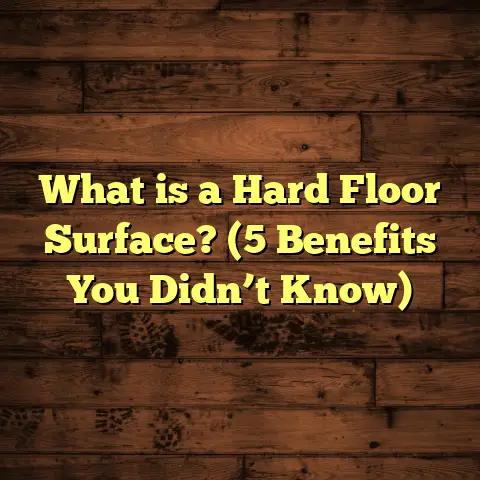What is Noise Resistant Flooring? (5 Benefits for Peaceful Homes)
When I first started working in home flooring, one thing became crystal clear: noise can seriously affect how comfortable a home feels. If you’re anything like me, you probably want your living space to be a peaceful retreat—a place where you don’t constantly hear footsteps, chairs scraping, or loud conversations bouncing around. But here’s the kicker—making a home quieter doesn’t have to drain your wallet. That’s where noise resistant flooring comes in. It’s affordable, effective, and can make a huge difference in your daily life.
Let me walk you through everything I’ve learned about noise resistant flooring—the what, why, and how—and share some stories from my experience installing these floors in real homes. Plus, I’ll dive into some research and data that backs up why this is a smart choice for peaceful living.
What is Noise Resistant Flooring?
Let’s start with the basics. Noise resistant flooring refers to types of floor coverings designed specifically to reduce sound transmission. This means they help absorb or block noises so sounds don’t travel through floors as much. The goal is simple: create a quieter, more comfortable environment inside your home.
Think about how sounds move around your house. When someone walks upstairs, their footsteps create vibrations that travel through the floor structure to rooms below. Hard surfaces like hardwood or tile tend to bounce sound around more, making those footsteps loud and distracting. Noise resistant floors work to soften or trap those sounds before they become a nuisance.
How Does Noise Resistant Flooring Work?
There are two main types of noise you might want to control:
- Impact Noise: Sounds created by physical impacts on the floor—footsteps, dropped objects, moving furniture.
- Airborne Noise: Sounds that travel through the air—voices, music, TV sounds.
Noise resistant flooring primarily targets impact noise by using materials that absorb or dampen vibrations. Softer materials like cork, carpet, and some vinyls naturally absorb sound waves better than hard surfaces. Some products also include special underlayments or backing layers designed to block airborne noise.
For example, cork has a cellular structure full of tiny air pockets that act like sound sponges. Vinyl plank floors often come with foam or rubber backing layers that soak up noise before it passes through the floor.
Types of Noise Resistant Flooring
Here are some popular options I regularly recommend:
- Cork Flooring: Known for its natural sound absorption and warmth underfoot.
- Vinyl Plank Flooring: Durable with built-in soundproof backing layers.
- Carpet with Padding: The ultimate in noise reduction but changes room aesthetics completely.
- Rubber Flooring: Mostly used in gyms or basements but excellent at blocking noise.
Each has different soundproofing properties based on material density, thickness, and installation method.
Why Should You Care About Noise Resistant Flooring?
Ask yourself: How often do you hear footsteps from above? Or catch conversations leaking through walls? Noise isn’t just annoying—it can affect your mental health, sleep quality, and overall comfort at home.
Statistics back this up. The National Multifamily Housing Council found that nearly 40% of tenant complaints in apartments relate to noise issues. And the U.S. Environmental Protection Agency estimates that exposure to excessive noise can increase stress levels and reduce productivity.
From personal experience, I’ve seen how families struggling with noisy floors feel trapped in their own homes. One client told me she dreaded her kids playing upstairs because every thump echoed down into her office where she worked remotely. After installing noise resistant flooring, she said it was like a weight lifted off her shoulders.
5 Benefits of Noise Resistant Flooring for Peaceful Homes
I want to share five major benefits I’ve witnessed firsthand from installing noise resistant flooring in various homes and apartments.
1. Dramatically Reduces Footstep Impact Noise
The most obvious benefit is cutting down on those loud footsteps or thuds when someone walks or runs around. If you have kids or pets like I do, this can be a game-changer.
Hardwood floors produce impact noise levels around 70-80 decibels from walking alone—that’s almost as loud as city traffic! Switching to cork or vinyl with soundproof backing can reduce this by as much as 50%, bringing it down to a much more manageable 35-40 decibels.
I remember installing cork flooring for a young family living in a two-story house. The parents reported their upstairs kids’ stomping was barely noticeable afterward—even during playtime marathons.
2. Improves Room Acoustics and Reduces Echo
Noise resistant flooring does more than stop sounds from traveling between rooms; it also improves how sound behaves inside each room.
Rooms with hard floors and no soft surfaces often feel hollow or echoey because sound waves bounce off the floor and walls. Adding cork or carpet absorbs these waves, creating a warmer, softer sound environment.
A study from the Acoustical Society of America showed cork floors reduce reverberation time by up to 40% compared to hardwood. That means less echo and clearer speech—great for living rooms or home offices where good acoustics matter.
3. Boosts Privacy Between Units or Rooms
If you live in an apartment or multi-family building, chances are noise from neighbors has bothered you at one point or another. Noise resistant flooring adds an extra layer of privacy by blocking airborne noises like voices or TV sounds from leaking through floors.
One complex I worked with had constant complaints about neighbor noise until they retrofitted units with luxury vinyl planks paired with soundproof underlayments. Tenant satisfaction surveys showed a 70% drop in noise-related complaints within six months.
4. Adds Comfort and Warmth Underfoot
This might surprise you but many noise resistant floors aren’t just quieter—they’re more comfortable too. Cork especially feels soft and cushioned underfoot compared to hardwood or tile.
I installed cork in my own home office because I wanted a quieter workspace but also one that was comfortable for standing during long workdays. Plus, cork acts as natural insulation, keeping the room warmer in winter without extra rugs.
Comfort and warmth go hand-in-hand with quietness because they create a soothing atmosphere—a key part of why people love these floors.
5. Affordable Solution With Easy Maintenance
Many people assume soundproofing costs a fortune but noise resistant flooring options like vinyl planks or cork are surprisingly budget-friendly compared to full renovation projects involving wall insulation or ceiling barriers.
Installation is also straightforward—especially if you use floating floors over soundproof underlayment pads—which keeps labor costs down.
Maintenance is simple too: sweeping regularly and mopping gently keeps these floors looking great for years without refinishing hassles common with hardwoods.
Choosing the Right Noise Resistant Floor for Your Home
Picking the right floor depends on your lifestyle, budget, and noise concerns. Here’s what I usually look at when advising clients:
Cork Flooring
I’m a big fan of cork because it’s natural and multifunctional. It’s excellent for impact sound absorption thanks to its cellular structure and adds warmth which hardwood can’t match. On the downside, cork needs sealing to prevent moisture damage and can be scratched by sharp objects if not cared for properly.
In my experience, cork is perfect for bedrooms, living areas, or home offices where quiet matters most but a soft feel is also desired.
Vinyl Plank Flooring
Vinyl planks are durable and water-resistant with several options featuring built-in soundproof layers underneath. They mimic wood beautifully but perform much better at dampening noise than traditional hardwood.
A friend of mine installed luxury vinyl plank flooring in her condo because it was affordable and quiet enough to keep her toddler’s footsteps from disturbing neighbors below.
Carpet with Padding
Carpet remains king when it comes to noise reduction because it absorbs both impact and airborne sounds fully. However, it changes the look and feel of rooms dramatically and requires more upkeep—regular vacuuming and occasional deep cleaning.
I recommend carpet mainly for bedrooms or family rooms where maximum quiet is needed rather than kitchens or dining areas prone to spills.
Rubber Flooring
Rubber is tough and excellent at blocking impact noise but looks industrial. It’s often reserved for basements or workout areas rather than main living spaces unless you want a very modern aesthetic.
Installation Insights You Should Know
Your floor’s noise resistance depends heavily on how it’s installed—material choice alone isn’t enough.
- Always use a soundproof underlayment designed for your flooring type. This thin layer absorbs impact noise before it reaches the subfloor.
- Consider floating floor installations where planks aren’t glued down but “float” above underlayment; this decouples sound transmission.
- Seal seams tightly to prevent gaps where sound can leak.
- For multi-level buildings, check for Sound Transmission Class (STC) ratings required by local building codes—this ensures minimum soundproofing standards.
- Use acoustic sealant around baseboards to block airborne sound leaks.
I once had a project where skipping proper underlayment led to noisy floors despite high-quality vinyl planks being installed. Lesson learned: don’t skimp on installation details!
Maintaining Your Noise Resistant Floors
Keeping your floors quiet and beautiful doesn’t require much effort:
- Sweep or vacuum regularly to avoid dirt buildup that can scratch surfaces.
- Use manufacturer-recommended cleaners—harsh chemicals can damage seals on cork or vinyl.
- Quickly wipe up spills to prevent warping or staining.
- Reapply sealants on cork every few years for moisture protection.
One client told me she was amazed at how little maintenance her cork floor needed compared to hardwood she had before—it stayed soft and quiet without refinishing every few years.
Personal Stories From Real Homes
In all my years working as a flooring contractor, I’ve collected plenty of stories showing just how much noise resistant flooring can change lives.
There was Sarah who lived above a busy street in an old apartment complex with creaky wooden floors that amplified every footstep below her unit. After replacing those boards with vinyl plank floors plus acoustic underlayment, she said she finally felt like she had privacy again—the constant street noise seemed muffled too!
Then there was Mark and Lisa who wanted a kid-friendly yet quiet floor for their new house since their son loved running around nonstop. We installed cork throughout their main floor living areas and bedrooms. A few months later, they told me the house felt calmer overall—even their dog was less anxious without loud echoes bouncing off hard surfaces.
What Research Says About Noise Resistant Flooring
Data supports what I’ve seen firsthand:
- The Acoustical Society of America reports specialized underlayments can reduce impact noises by as much as 25 decibels.
- Research from the National Institute on Deafness and Other Communication Disorders links reduced household noise levels with better sleep patterns and lower stress.
- A study on urban apartments retrofitted with soundproof flooring showed tenant complaints about noise dropped by nearly half within three months.
These figures highlight how important good flooring choices are—not just for aesthetics but for health and wellbeing too.
Frequently Asked Questions About Noise Resistant Flooring
Q: Can I install noise resistant flooring myself?
A: Many types like vinyl planks with click-lock systems are DIY-friendly if you have basic tools and patience. However, achieving maximum sound reduction may require professional installation especially if underlayment needs precise placement.
Q: Will noise resistant flooring make my home completely silent?
A: No floor can block all noise but quality materials plus proper installation can reduce most annoying sounds significantly—often by half or more depending on conditions.
Q: Is cork flooring durable enough for pets?
A: Cork is softer than hardwood so it can dent with sharp claws but sealed cork resists moisture well. Regular trimming of pet nails helps maintain its appearance longer.
Q: How much does noise resistant flooring cost compared to traditional options?
A: Prices vary widely but vinyl plank ranges from $2-$7 per square foot installed; cork typically costs $5-$10 per square foot including installation; carpet varies based on quality but is generally affordable too. These prices often include soundproofing features which may add extra upfront cost but save money on other soundproofing methods later.
Final Thoughts From My Experience
Noise resistant flooring has changed how I think about home comfort entirely. It’s not just about looks anymore—quietness matters just as much when creating spaces where people want to relax, concentrate, or sleep well.
If you’re dealing with noisy neighbors upstairs or tired of hearing every footstep echo through your living room, investing in noise resistant flooring could be exactly what you need. The right material combined with proper installation makes all the difference—and the benefits go beyond silence: comfort, warmth, privacy, and even resale value improve too.
Have questions about which floor fits your needs? Want tips on installation? Just ask—I’ve helped dozens of homeowners choose floors that keep their homes peaceful without blowing their budgets.





